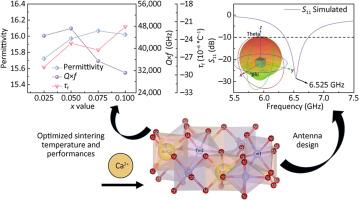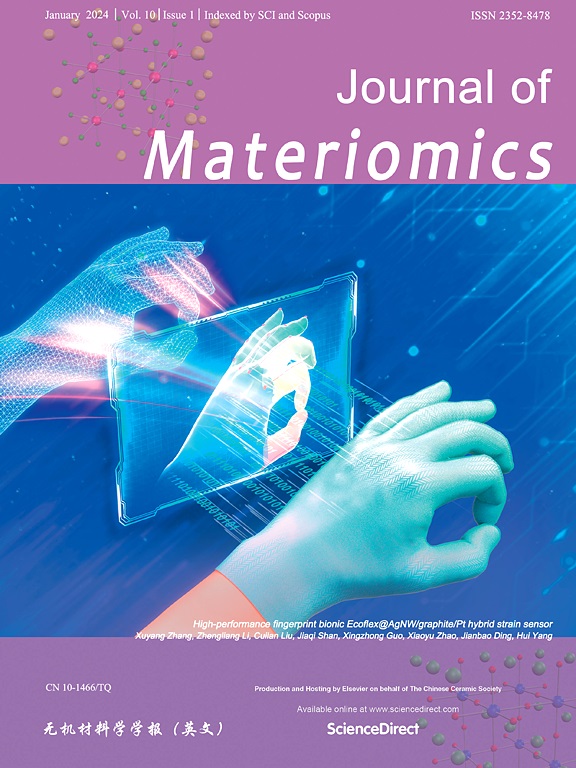Investigation of crystal structure and chemical bonds characteristics on microwave properties of novel Ca-doped Sr1–xCaxTm2O4 (x=0.025–0.300) ceramics
IF 9.6
1区 材料科学
Q1 CHEMISTRY, PHYSICAL
引用次数: 0
Abstract
Dense microwave dielectric ceramics of Sr1–xCaxTm2O4 (x = 0.025–0.300) were fabricated via the conventional solid-state reaction method. Systematical investigations on the impact of Ca2+ on their microstructures, sintering behaviors, and microwave dielectric properties were detailly conducted. The combined XRD data and subsequent refinement demonstrated that all samples exhibited structural conformity with SrTm2O4 and belonged to Pnam space group. Calculations were executed to illustrate the evolution of performance-related chemical bonding parameters associated with Ca2+ on the basis of the PVL theory. High density, lattice energy and narrow full width at half maximum of Raman modes contribute to a performance boost of around 14%. Excellent dielectric properties of Sr0.95Ca0.05Tm2O4, including relative permittivity of 15.97, quality factor of 47,142 GHz, and temperature coefficient of resonant frequency of −24.65 × 10−6 °C−1. Furthermore, Sr0.95Ca0.05Tm2O4 ceramics were designed as rectangular dielectric resonator antennas with 388 MHz bandwidth at the center frequency of 6.525 GHz, along with high simulated radiation efficiency (≥90%) and realized gain (5.80–6.47 dBi), which suggests their considerable potential in 5G communication applications.


新型掺钙Sr1-xCaxTm2O4 (x= 0.025-0.300)陶瓷的晶体结构和化学键特性对微波性能的影响
采用常规固相反应法制备了Sr1-xCaxTm2O4 (x = 0.025-0.300)致密微波介质陶瓷。系统地研究了Ca2+对其显微结构、烧结行为和微波介电性能的影响。结合XRD数据和随后的细化表明,所有样品的结构与SrTm2O4一致,属于Pnam空间群。在PVL理论的基础上,计算了与Ca2+相关的性能相关的化学键参数的演变。高密度、晶格能量和拉曼模式半最大值时窄全宽有助于性能提升约14%。Sr0.95Ca0.05Tm2O4具有优异的介电性能,相对介电常数为15.97,质量因子为47,142 GHz,谐振频率温度系数为-24.65×10−6°C-1。此外,Sr0.95Ca0.05Tm2O4陶瓷被设计为矩形介质谐振器天线,中心频率为6.525 GHz,带宽为388 MHz,具有较高的模拟辐射效率(≥90%)和实现增益(5.80-6.47 dBi),在5G通信应用中具有相当大的潜力。
本文章由计算机程序翻译,如有差异,请以英文原文为准。
求助全文
约1分钟内获得全文
求助全文
来源期刊

Journal of Materiomics
Materials Science-Metals and Alloys
CiteScore
14.30
自引率
6.40%
发文量
331
审稿时长
37 days
期刊介绍:
The Journal of Materiomics is a peer-reviewed open-access journal that aims to serve as a forum for the continuous dissemination of research within the field of materials science. It particularly emphasizes systematic studies on the relationships between composition, processing, structure, property, and performance of advanced materials. The journal is supported by the Chinese Ceramic Society and is indexed in SCIE and Scopus. It is commonly referred to as J Materiomics.
 求助内容:
求助内容: 应助结果提醒方式:
应助结果提醒方式:


